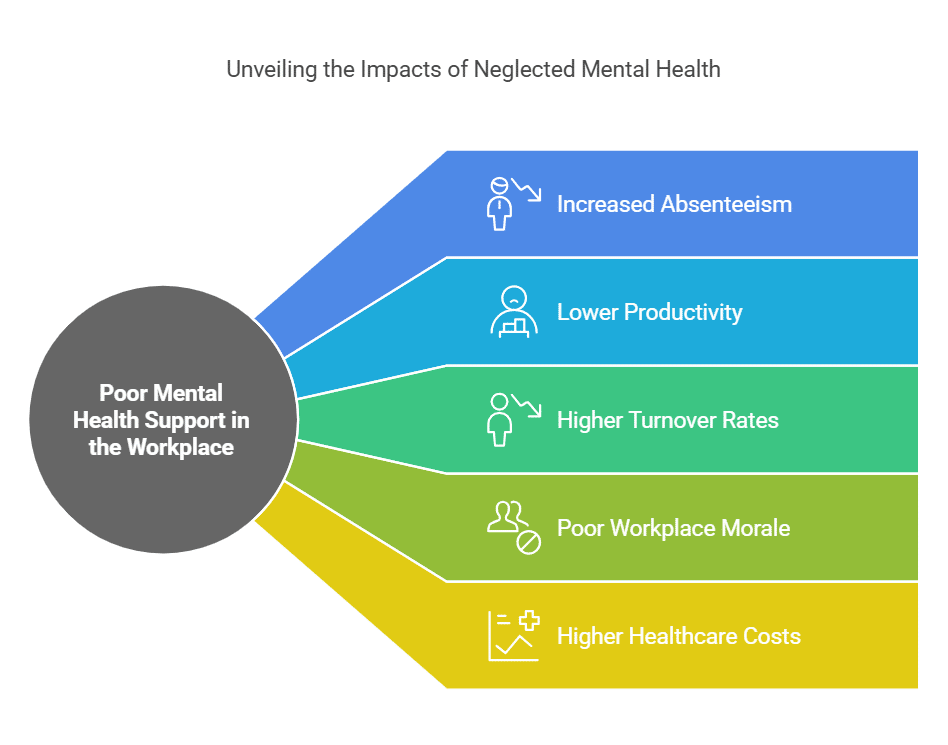Mental health is an essential aspect of overall well-being, yet it remains one of the most overlooked aspects in many workplaces. Employees often struggle in silence, fearing judgment or negative repercussions if they open up about their mental health challenges. This reluctance can lead to burnout, decreased productivity, and increased turnover rates.
Creating a safe space for mental health discussions at work is crucial for fostering a supportive environment where employees feel valued and heard.
A workplace that prioritizes mental health not only improves employee morale but also boosts efficiency and retention rates. In this article, we will explore actionable strategies to create a safe space for mental health discussions at work and ensure a healthy work environment for all. Additionally, we will examine case studies and real-world examples to highlight best practices.
Understanding the Need for a Safe Space at Work
A workplace that ignores mental health issues faces numerous challenges, including decreased employee performance, low engagement, and high absenteeism. Mental health conditions such as anxiety, depression, and stress can significantly affect an employee’s ability to focus and meet deadlines.
Key Impacts of Poor Mental Health at Work:
| Impact | Description |
| Increased absenteeism | Employees take more sick leaves due to stress and burnout. |
| Lower productivity | Reduced efficiency due to lack of focus and motivation. |
| Higher turnover rates | Employees leave organizations that fail to provide mental health support. |
| Poor workplace morale | A negative work environment reduces collaboration and innovation. |
| Higher healthcare costs | Increased medical claims due to stress-related health issues. |
Why Employees Hesitate to Speak About Mental Health
Despite the growing awareness of mental health, many employees hesitate to speak up due to various concerns.
Common Barriers Preventing Open Discussions:
| Barrier | Explanation |
| Fear of judgment | Employees worry about being perceived as weak or unprofessional. |
| Job security concerns | Concerns that mental health issues could impact promotions or job stability. |
| Lack of trust in management | Employees feel management may not take their issues seriously. |
| Absence of mental health policies | No clear framework to provide mental health support in the workplace. |
Key Strategies to Foster a Safe Space
A workplace culture that values mental health creates a safe space for open discussions. Employees should feel comfortable expressing their challenges without fear of negative consequences.
Ways to Build a Supportive Culture:
| Action | Benefit |
| Encourage leadership to discuss mental health | Sets a positive example for employees. |
| Promote inclusivity and psychological safety | Ensures every employee feels valued and respected. |
| Recognize and reward mental well-being efforts | Encourages participation in mental health initiatives. |
Implementing Clear Mental Health Policies
Workplaces must establish well-defined policies that provide support to employees facing mental health challenges.
Essential Elements of Effective Policies:
| Policy Element | Purpose |
| Mental health leave policies | Allows employees to take time off for recovery. |
| Confidentiality agreements | Ensures employees feel safe discussing their concerns. |
| Employee Assistance Programs (EAPs) | Provides professional counseling services. |
| Workplace accommodations | Adjustments such as flexible hours or remote work options. |
Training Leaders and Employees
Proper training ensures that employees and managers can identify signs of mental health struggles and provide the necessary support.
Types of Training:
| Training Type | Objective |
| Mental health awareness workshops | Educates employees on recognizing signs of mental distress. |
| Managerial training | Teaches leaders how to provide compassionate support. |
| Crisis intervention techniques | Helps in responding to employees in mental health crises. |
Creating Safe and Open Communication Channels
Encouraging dialogue around mental health can be achieved by offering multiple avenues for employees to share their thoughts.
Effective Communication Strategies:
| Strategy | Benefit |
| Anonymous feedback surveys | Allows employees to express concerns without fear. |
| Dedicated mental health forums | Encourages peer support and shared experiences. |
| Monthly check-in meetings | Provides a platform for employees to discuss well-being. |
Case Study: How Google Promotes Mental Health Discussions
Google has successfully implemented mental health initiatives by creating a culture of openness and support. The company provides free counseling services, mental health days, and regular well-being check-ins for employees. Google’s approach has resulted in increased productivity and employee satisfaction, demonstrating the effectiveness of workplace mental health programs.
Measuring the Success of Workplace Mental Health Initiatives
Organizations should track specific metrics to measure the effectiveness of their mental health initiatives.
| KPI | Description |
| Employee Engagement Score | Measures workplace satisfaction levels. |
| Absenteeism Rate | Tracks mental health-related absences. |
| Employee Turnover Rate | Indicates retention levels due to mental health support. |
| Utilization of EAPs | Evaluates employee participation in mental health programs. |
Adjusting Strategies Based on Employee Needs
Mental health initiatives should be flexible and continuously improved based on feedback.
Ways to Improve Initiatives:
| Action | Outcome |
| Conduct quarterly evaluations | Ensures initiatives remain effective. |
| Adapt policies based on feedback | Addresses evolving employee concerns. |
| Encourage employees to participate in decision-making | Creates a sense of ownership and trust. |
Takeaways
Creating a safe space for mental health discussions at work is a collective effort that requires commitment from leadership, HR, and employees.
By fostering a supportive culture, implementing clear policies, providing resources, and encouraging open communication, organizations can create a mentally healthy workplace.
A workplace that prioritizes mental health sees increased productivity, improved employee satisfaction, and lower turnover rates. By continuously evaluating and refining strategies, organizations can ensure a long-term commitment to mental well-being.
Investing in mental health today will lead to a happier, healthier, and more productive workforce tomorrow. Start making a difference in your workplace now by creating a safe space for mental health discussions at work!







































